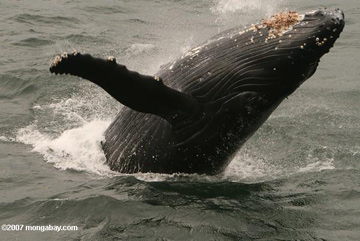IWC issues media blackout on discussions to lift whaling ban
IWC issues media blackout on discussions to lift whaling ban
Jeremey Hance, mongabay.com
September 11, 2008
The fate of the ban on whale hunting to be decided behind closed doors
The survival of whales is perhaps the most successful conservation story of the 20th century. Since a moratorium on commercial hunting, some whale species have staged dramatic recoveries. In May it was announced that the humpback whale population has climbed from 1,500 to 20,000 individuals, resulting in it being “downlisted” from vulnerable to least concern, according to the IUCN’s Red List. Others, like the blue whale, appear to have stable populations but recovery remains slow.
The moratorium on hunting, begun in 1982, was the decisive moment for whale conservation. Next week, the fate of that moratorium will be decided by the International Whaling Commission (IWC). In St. Petersburg, Florida twenty-six of the eighty nations making up the IWC will gather under a media-blackout to discuss the continuance of the commercial hunting ban on whales.
"These closed-door meetings pose a grave risk to the future of the IWC and the whales it was established to protect," said Patrick R. Ramage, Global Whale Program Director of the International Fund for Animal Welfare (IFAW). "Whales face more threats today than at any time in history and Americans from sea to shining sea want to see them protected. The last thing we need is a secret deal to re-open whaling.”
 Humpback whale in Alaska |
Despite the moratorium a few nations continue commercial whaling. Both Iceland and Japan partake in annual hunts, stating that their whaling is only conducted for scientific purposes. Many conservationists, however, believe that scientific whaling is just a cover for commercial whaling. Japan remains the world’s largest consumer of whale products and meat is widely available in grocery stores, restaurants, and even children’s school lunches. Norway also actively participates in commercial whaling. But Norway is not bound by the IWC moratorium, since it is not a member of the commission. Collectively, these few nations have killed 30,000 whales since hunting resumed in 1986. Conservationists believe that if the whaling ban is lifted, the number of whales killed every year will rise exponentially.
"The global ban on commercial whaling was one of the most important conservation victories of the last century," Ramage said. "If Japan, Norway, and Iceland, the last three countries engaged in commercial whaling are successful in their efforts to overturn the whaling ban, forty years of conservation efforts will go right down the drain."
Whale populations still face a variety of threats, even without commercial hunting, such as collisions with ships, pollution, by-catch, seismic testing for oil, the use of sonar, and climate change. In addition, whale numbers lag far behind their original abundance. Despite successful population growth, humpback whales have recovered only 2 percent of their estimated historic population.
Many of the twenty-six nations attending the meeting in St. Petersburg are suspected of being aligned with Japan and Iceland in their desire to lift the ban on whaling. In an op-ed piece, Ramage states that he believes the Bush administration is preparing to allow the ban to be lifted in order to placate Japan. The IWC chairman, William Hogarth, is a Bush administration appointee.
Ramage says that Hogarth, “should either open up the process for scrutiny, or simply cancel the meetings."













